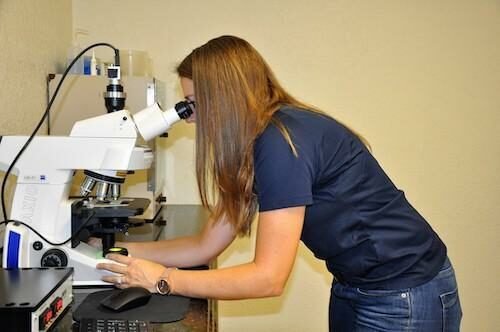Tag: atwood
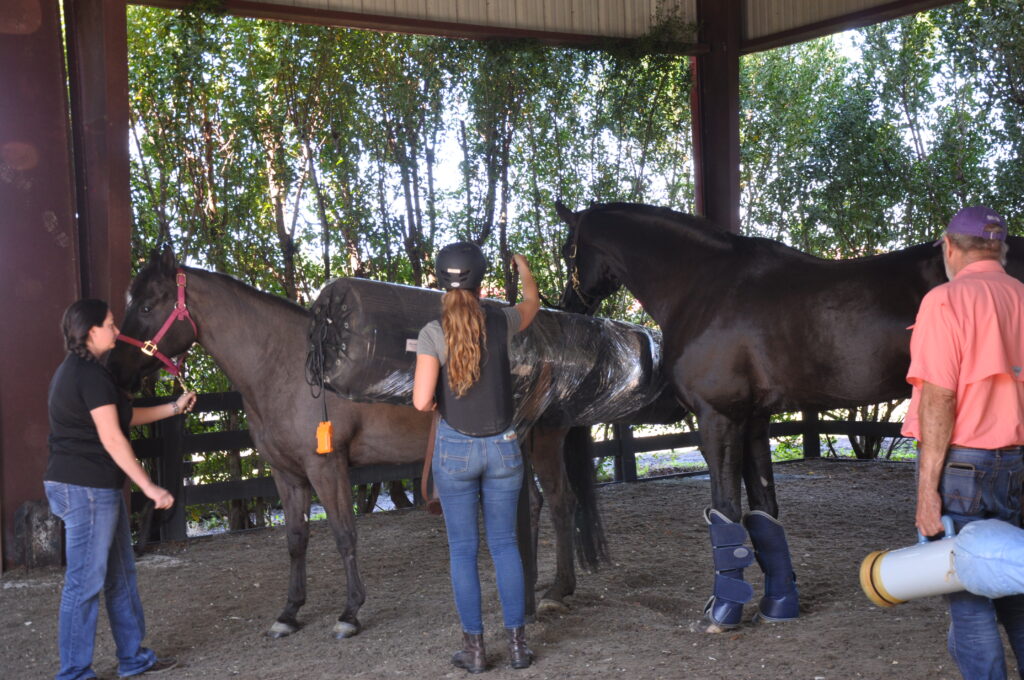
While the traditional breeding process needs no explanation, there are multiple avenues available when it comes to producing a foal. It is important to understand your horse’s reproductive options before starting the breeding process, such as the different conception rates between fresh-cooled and frozen semen or how to guarantee a live foal out of your breeding contract. Palm Beach Equine Clinic veterinarian Dr. Katie Atwood previously guided us through what to expect regarding the mare’s side of this equation, and below she explains several considerations for the stallion’s side.
Start with the Future Foal’s Purpose
When selecting a stallion for semen purchase, the first step is to assess what will be the foal’s purpose and projected goals. Many mare owners will recognize certain weaknesses in their horse and choose a stallion that could compensate for those shortcomings to create the ideal foal. For example, if the mare doesn’t have the scope they would like to have in the foal, an owner might choose a particularly scopey* stallion. Chances are in favor of two talented horses creating a talented foal. However, Dr. Atwood stresses that it is impossible to guarantee that a certain mare and stallion combination will produce the desired result.
“In breeding thoroughbred racehorses, we see a lot of examples of this,” explains Dr. Atwood. “Some owners will repetitively breed a racing stallion but none of his foals will accomplish anything close in comparison to his accolades. You can’t always predict what will come out of the breeding match.”
Still, Dr. Atwood makes a point of impressing upon her clients the importance of first knowing what they want for the foal’s future. Then, consider the health, genetic makeup, and bloodlines of the parents-to-be.

“There are a few genetic diseases that are little known and currently being more researched, such as Warmblood Fragile Foal Syndrome and Hyperkalemic Periodic Paralysis. Testing for these diseases is becoming more common. There are also hereditary traits such as cryptorchidism or conformational issues which are genetically predisposed. Conformational traits can be a factor, so it’s important to take these into consideration when choosing the stallion,” says Dr. Atwood.
Minimizing Risk Through a Breeding Contract
“It is important to have a solid breeding contract in place,” Dr. Atwood recommends. “A detailed agreement gives the owner of the mare specific guidelines as to what they are entitled to receive.”

Every breeding contract is slightly different, so you need to read yours carefully and ask questions. The breeding contract should outline the fees, rebreeding rights, the method of breeding, and the number of doses of semen. Some contracts include a live foal guarantee, which means that you will receive doses of semen until your mare produces a foal that stands and nurses.
Depending on the stallion and his semen availability, you may have a certain number of breedings, or rounds of semen shipments, per breeding season outlined in the contract. The contract, however, can be amended and Dr. Atwood finds this is a common practice because of the unforeseen possibilities that accompany reproduction.
“It can be extremely variable, but many stallion owners, depending on the demand for that stallion and his availability, are flexible,” she notes. “So, if you have an issue with breeding your mare, it’s worthwhile to ask the stallion’s owner to amend the contract. For example, if it is late in the breeding season and the mare’s owner chooses not to continue breeding that season but would like to try the next season, a lot of times the stallion’s owner will agree to extend the contract to the following year for a fee.”
The Stallion’s Breeding Options
You can breed your horse through live cover, artificial insemination with fresh semen, fresh-cooled semen, or frozen semen. The success of any breeding method resulting in a pregnancy is extremely dependent on the mare and stallion and their management. The mare’s age, her prior number of pregnancies, and reproductive health are crucial, as well as the stallion’s fertility, the number of mares he is booked to, and the handling and processing of his semen. Artificial insemination with fresh-cooled or frozen semen is now the norm in sport horse breeding as there are fewer risks and logistical challenges.
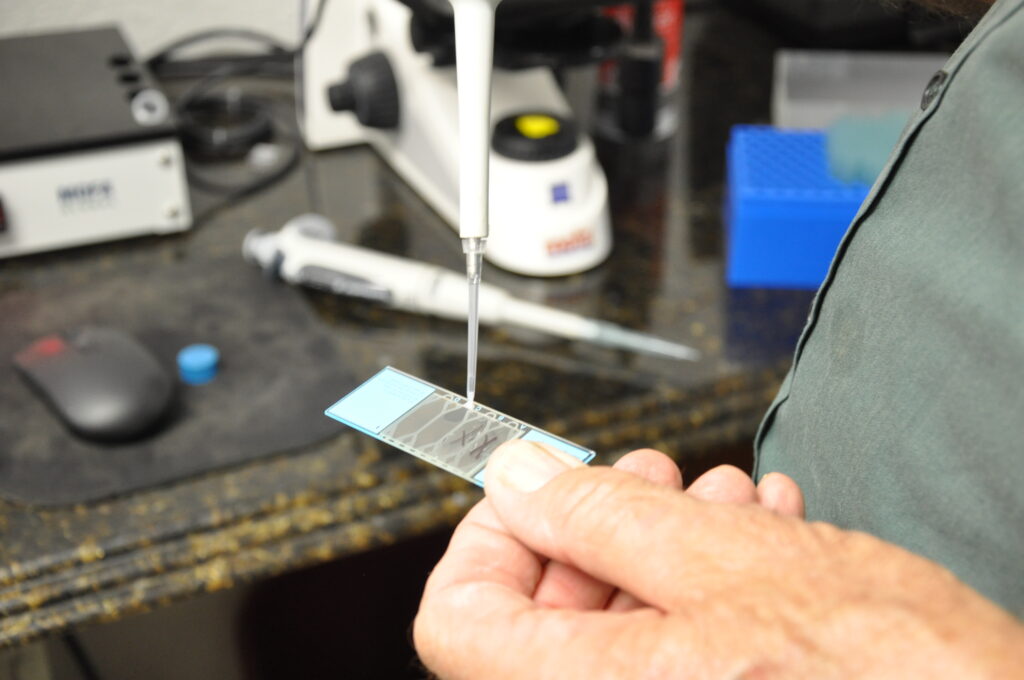
“The beauty of frozen semen is that it lasts forever,” Dr. Atwood says. “Once frozen and appropriately maintained, it is, in theory, good forever. The interesting part is that this can help diversify bloodlines. Sport horses have evolved a lot over the last several decades, and the traits we look for in a horse have evolved as well. There are qualities that we may have overlooked in certain breeds or disciplines because of trends or preferences at that time. With frozen semen, you can go back to a stallion frozen years ago who may be a great option for your mare.”
Not all stallions’ semen can be frozen successfully as some are unable to thaw and still produce a pregnancy. Another option Dr. Atwood recommends is fresh cooled semen, which is often a good choice when breeding an older mare.
“I’ve had instances with mares that couldn’t get pregnant with the owner’s first choice in frozen semen. In that case, I do recommend going with a different stallion or fresh-cooled if available. Fresh-cooled semen is a great option because the sperm is healthier in theory; they are younger, and their motility is usually better.”
What’s Involved in Breeding with Fresh or Frozen Semen
Many veterinarians process, freeze, and package their breeding doses differently, but with the same goal of providing enough to ensure a pregnancy. Industry experts recommend one billion progressively motile sperm per breeding dose. Realistically, half of the sperm will be dead upon arrival and the resulting 500 million progressively motile sperm is found to be an appropriate amount.

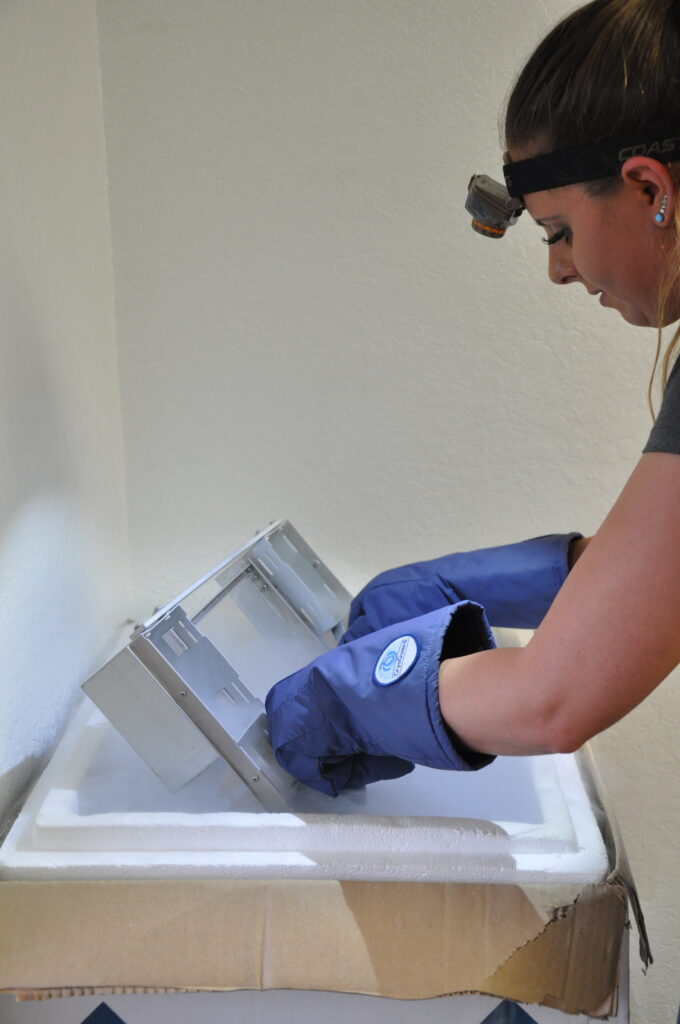
“A lot of people say, ‘you only need one sperm’ to which the answer is yes, in theory, you only need one sperm, but you still need the rest of them to push that one sperm along,” explained Dr. Atwood. “You can’t just put a single sperm in a uterus and expect to get a foal. It just doesn’t work that way because you need a higher volume to build momentum and get that one sperm where it needs to go to form an embryo.”
With fresh-cooled semen, Dr. Atwood checks the mare to see if she is ready to be bred and if so, she schedules the stallion to be collected the next day. With the collection, she utilizes a Computer Assisted Sperm Analyzer (CASA) to assess certain parameters of the stallion’s fertility and then uses a cooling extender agent to preserve the quality of the sperm. The mare can be bred and then checked 24 hours later.
If freezing the semen, Dr. Atwood will process and analyze the sperm, also use an extending agent, and then a cryoprotectant to prevent damage to the sperm during the freeze. She packages the sperm into four to eight half-millimeter straws per breeding dose. Then the semen is placed on a rack and cooled in a temperature-adjustable fridge to prevent damage or sudden shock before freezing. The straws can then be placed into a vapor box for about 20 minutes before being submerged in a liquid nitrogen tank and stored indefinitely. When using frozen semen, once the mare is close to ovulating, she is given an ovulatory agent to help the process begin within 36-48 hours.

If you’re considering breeding your horse, having a knowledgeable veterinary partner on your team will help streamline the breeding process. They will be able to address any questions or concerns about your individual mare and stallion combination, and maximize your chances of producing a healthy foal. Speak with a veterinarian about your horse’s breeding options by calling Palm Beach Equine Clinic at 561-793-1599 or visit www.equineclinic.com/reproduction-and-fertility.
*A horse that jumps with little effort and great power is thought to have scope and considered to be scopey.
Considerations for Breeding the Sport Horse Mare
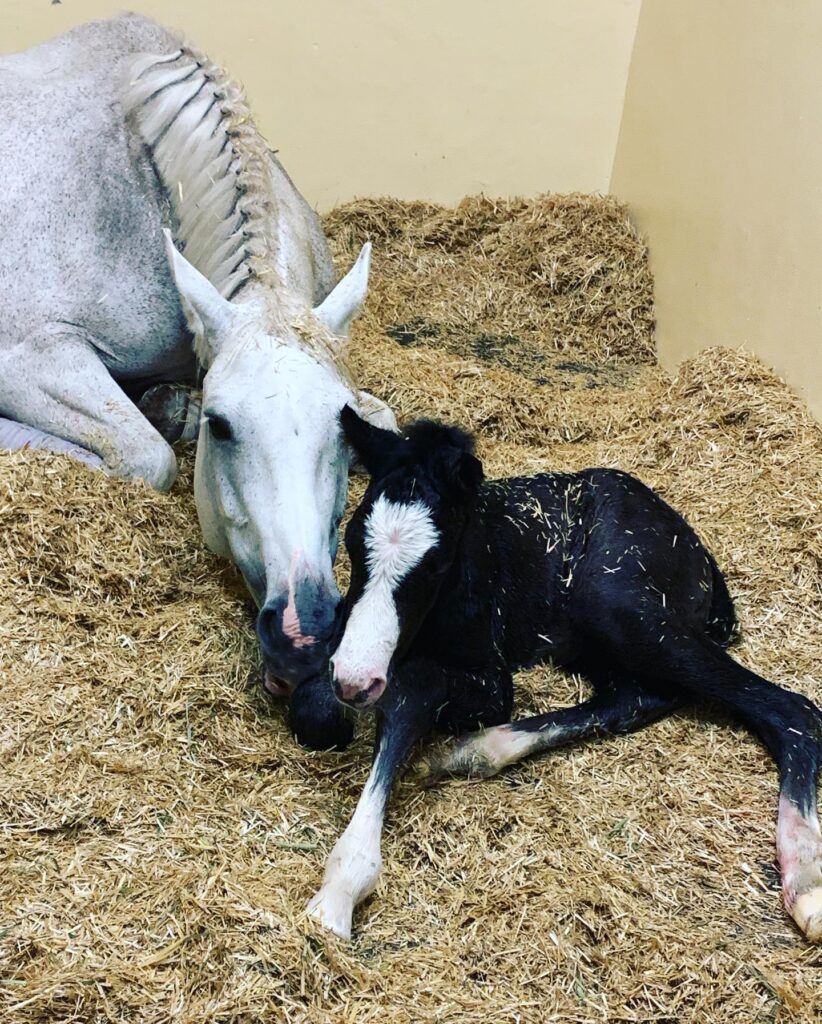
Breeding is not typically on the forefront of owners’ minds when it comes to their high-performance sport horse mare. The focus is mostly on keeping those mares at their best, in terms of health, athleticism, and performance. Prospects for them being bred are usually reserved for well after their competition schedule winds down.
Often when sport horse mares are injured and their careers are either put on hold or cut short altogether, breeding may become the next best option for the owner to consider. Depending on the injury sustained and their overall health and age, breeding can be a great alternative for the out-of-work mare. However, modern reproduction techniques have made breeding the sport horse mare not only an option reserved for after their careers have come to a close. Through embryo transfer, mares can produce multiple foals during the same season all while continuing their training and competition schedules.
With the possibility of breeding comes a significant number of unknowns, so we asked Palm Beach Equine Clinic veterinarian Dr. Katie Atwood to guide us through the process of examining a mares’ reproductive health and the different options for creating a foal.
Start with a vision for the future foal
The first step when embarking on the breeding process is to choose the stallion. This decision hinges entirely on what the owner’s vision and end goal may be for the future foal.
“The owner will need to know what they want that future foal’s purpose to be before choosing a stallion,” Dr. Atwood explained. “Owners should already be in the process of choosing a stallion or have already decided before examining the mare.”
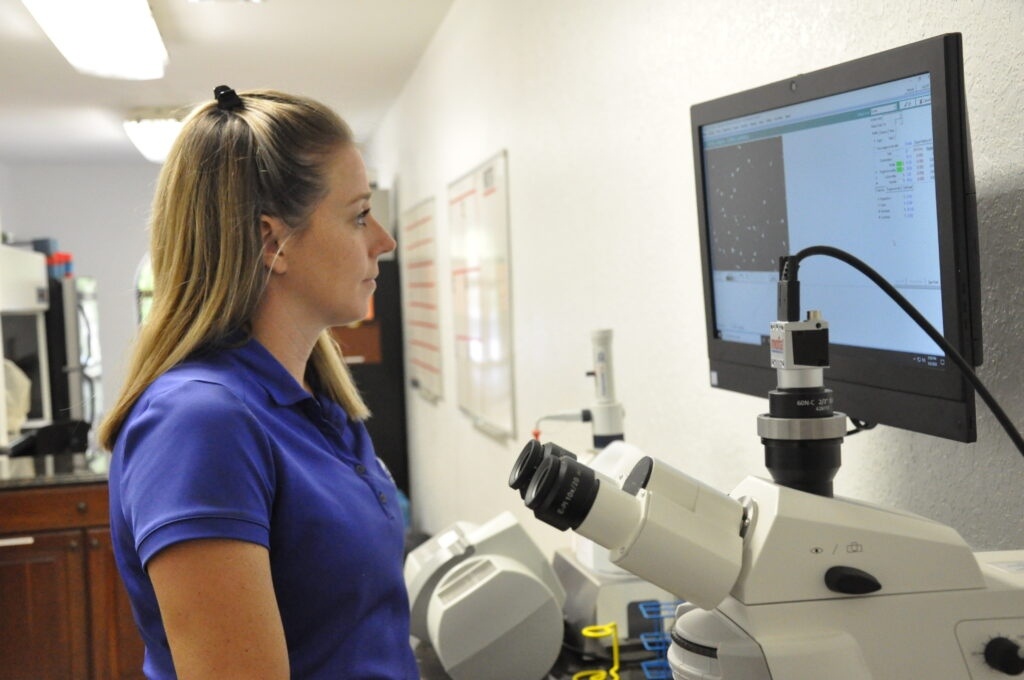
“There are countless breeding stallions across all different breeds and disciplines, and it all comes down to the owner’s opinion and preferences. If I have personally met the stallion, I can comment on their disposition, but I do not make recommendations on one stallion versus another. As the veterinarian, I pay attention to their health and fertility versus the external qualities that do not play a role in reproduction. I let the professionals – owners, riders, and trainers – make those decisions,” said Dr. Atwood.
Evaluating the mare’s reproductive soundness
After assessing the mare’s overall health and taking into account her breeding history, Dr. Atwood will begin with the reproductive soundness exam. This usually includes a rectal ultrasound and palpation of the uterus, ovaries, and cervix. Dr. Atwood also typically performs a vaginal speculum exam to examine the quality of the mare’s cervix. All the information that Dr. Atwood gathers during this step helps to determine what stage the mare is at in her estrous cycle, identify any potential issues, and establish the next steps.
“When performing that first ultrasound, I look for endometrial cysts, fluid or air, and mucus in the uterus,” said Dr. Atwood. “I examine both ovaries to make sure they appear normal and are cycling normally. There are a lot of elements that can change depending on the time of year and where the mare may be in her cycle. But if we are examining her during breeding season, then I can evaluate whether or not there are any abnormalities.”
During the ultrasound, Dr. Atwood will look for signs of Endometritis, an inflammation and infection of the most superficial layer of the uterus and a big reason why mares can’t get pregnant. It is important to identify issues such as this before taking any further steps.
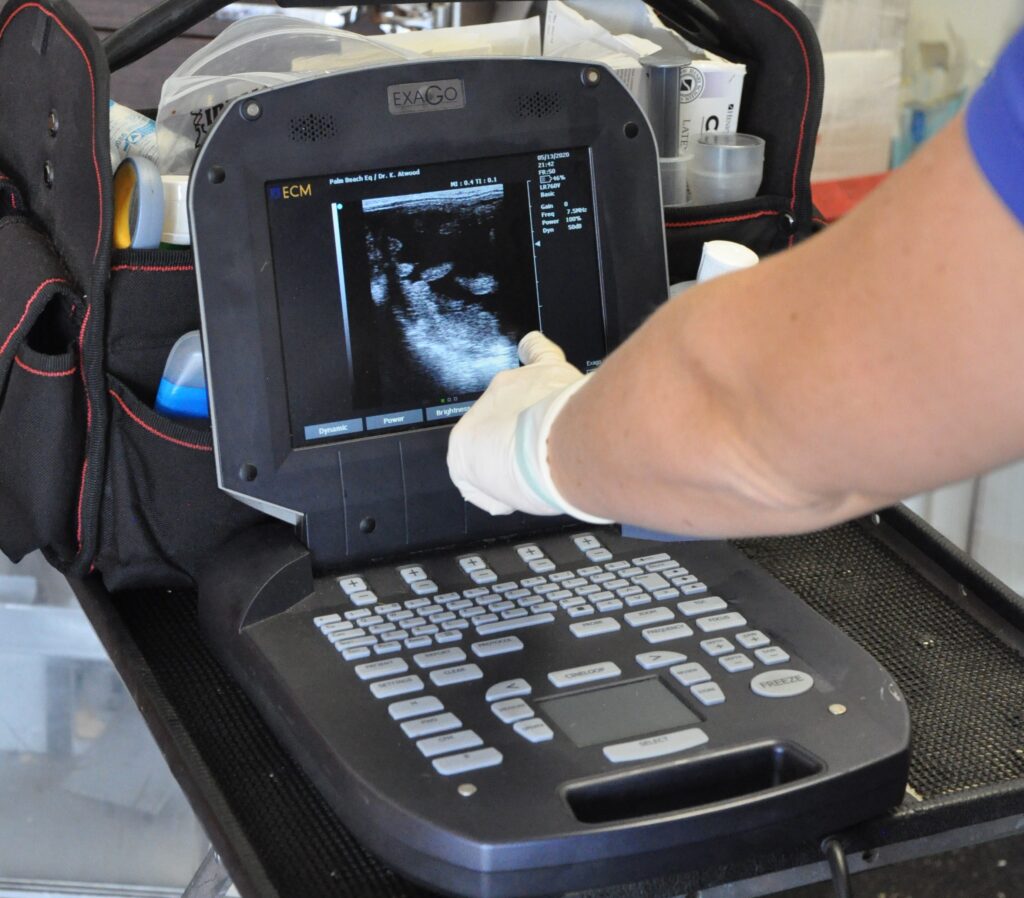

Age can bring about changes to the uterus, as can any previous pregnancies, so a uterine biopsy is also recommended for older mares (generally over 14 years old) before being bred. Some of those changes, such as fibrosis, are irreversible, which is also crucial to know before you proceed further with breeding.
Maiden mares can also have their own challenges if being bred for the first time at a later stage in their life. “When a middle-aged or older mare has not had a foal before, her cervix does not relax. This means that they more easily maintain fluid in their uterus and that can present its own complications,” commented Dr. Atwood. Dr. Atwood also notes that the conformation of the mare’s external genitalia needs to be taken into consideration. If the mare’s anatomy predisposes her to uterine infections, there will likely be complications throughout the pregnancy.
Getting the timing right
Since many sport horses will travel frequently over far distances and through different climates, its important to consider the mare’s natural estrous cycle and her best time for ovulation. “Here in south Florida, a lot of clients will want to breed their horse when they arrive for the winter season,” said Dr. Atwood. “Their mare may have been in New York for the last 8 months, so her uterus is still influx with New York seasons and she is anestrous, meaning that she is not cycling.”
When the mare is in her seasonal anestrous, her uterus is flaccid and her ovaries are not producing follicles. The veterinarian can administer a hormonal therapy to help trigger ovulation, however, Dr. Atwood tries to go the natural route whenever possible. In these situations where the owner wants to breed the mare and are traveling from up north, Dr. Atwood has a simple yet effective trick.
“I usually recommend putting the mare under lights starting in the beginning of December and lasting until they are bred. This is a very simple, economic way we can naturally stimulate the mare to cycle. The mare only needs to be under lights from 4 p.m. until 11 p.m. and the brightness test is that you’ll need to be able to read a newspaper in the darkest corner of the stall,” said Dr. Atwood.
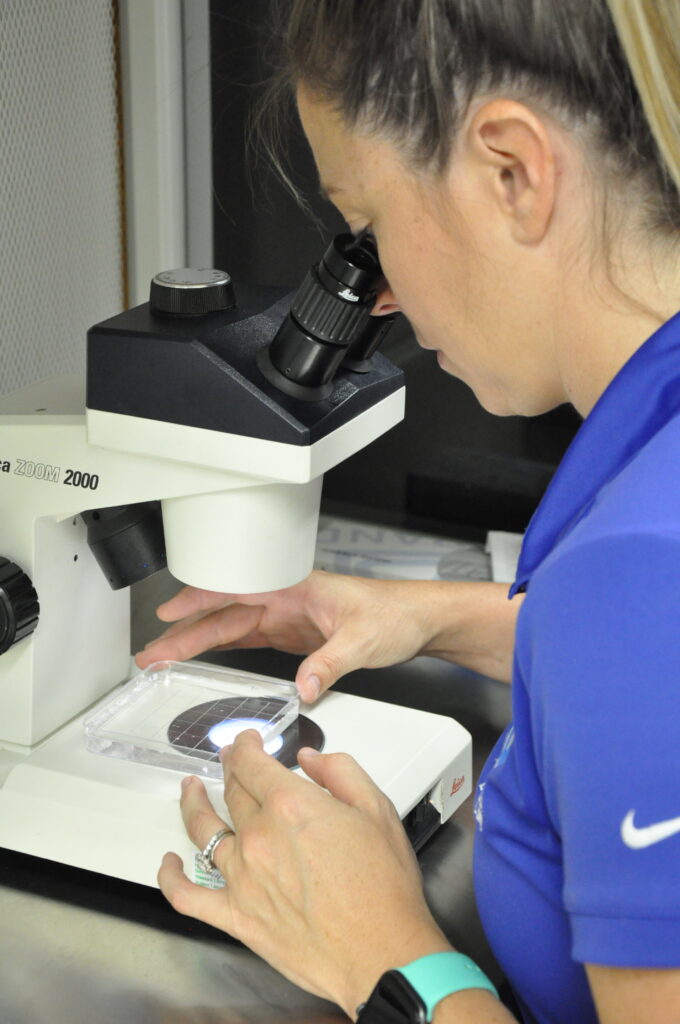
Considering a surrogate mare
Using a surrogate mare is one of the most popular routes for breeding sport horse mares. This process requires an embryo transfer, meaning that an embryo from the donor mare will be transferred to a surrogate, or recipient, mare to carry the foal to term. Embryo transfer has become a leading method for breeding as it relieves many of the owner’s concerns regarding the mare’s health and carrying the foal. It also allows the mare to be bred at an ideal reproductive age without any interruptions to their training and competition schedules.
“The average gestation period for a horse is 11 months and you’re only producing one foal per year with traditional breeding. Embryo transfer allows the mare to produce multiple foals per year while remaining in their normal routine,” commented Dr. Atwood.
What the surrogate mare process entails
Dr. Atwood cautions that a one-to-one ratio is not a good plan for a surrogate mare. In other words, she advises that you do not choose one single mare you’d like to be the surrogate, but rather go through a commercial recipient herd.

“I advise clients to not just rely on another one of their mares as a surrogate,” said Dr. Atwood. “In a perfect world, I would line up three recipient mares for every donor mare. The donor and recipient mares have to be on the same cycle because if you are going to take an embryo out, you have to put it in a uterus that’s ready for that embryo.”
Though the deposit to reserve a mare in a commercial herd can be costly and often nonrefundable, it guarantees that there will be a mare in the herd on any given day that is ready to receive the embryo. When it comes time for the embryo transfer, the mare whose uterus is the best quality on that day will receive the embryo. Prior to the embryo transfer, the donor mare will still undergo an ultrasound and palpation exam to determine her reproductive health.
Genetically, the recipient mare has no contribution to the genetic makeup of the foal if breeding through embryo transfer. The foal will be with that recipient mare from birth to weanling (six months), so there is a possibility that some of her personality traits could rub off but that is often not the case. “The recipient mare is usually under the age of eight, an appropriate size, and has a nice, calm disposition,” commented Dr. Atwood. “Some owners do have the recipient mare shipped to their personal barn during the last stages of the pregnancy because they want to be part of the foaling process or have their own team and veterinarian there for that process.”
Speak with a veterinarian about your mare’s breeding options

If you are considering breeding your mare, keep in mind the time of year, whether you’d like to use a surrogate, and what you want the final result to be. The breeding process can be a bit overwhelming, especially for those who are new to it, but Palm Beach Equine Clinic veterinarians are here to assist and guide you in the process whenever help is needed. At the end of the day, for Dr. Atwood, the reproductive process is her passion, so she is always eager to meet new patients and help plan for a new foal.
“I love the creation of life,” Dr. Atwood remarked. “Equine medicine is intriguing, but you’re usually handling sick, unhealthy animals. With reproduction, I am working with healthy animals and making their babies, which I love.”
Contact the Palm Beach Equine Clinic Reproduction Department:
The process of breeding sport horses is ever-changing. Whether in an effort to produce the healthiest, most talented foals, to prolong the competition career of a mare, or make the most of a stallion’s longevity, reproductive science in horses has come a long way from the days of the traditional breeding shed.
Dr. Katie Atwood is a member of the Palm Beach Equine Clinic team, based in Wellington, FL, with a passion for reproductive work. She has used that passion to help Palm Beach Equine Clinic offer cutting edge breeding options all in the heart of the winter equestrian capital of the world.
“I like the creating of life,” said Dr. Atwood, who is a Florida native and University of Florida graduate and currently pursuing steps to become a board-certified reproductive specialist. “Equine medicine is intriguing, but you’re dealing with sick, unhealthy animals. With reproduction, I am working with healthy animals and making their babies, which I love!”
The Future of Breeding at Palm Beach Equine Clinic
PBEC is a one-stop shop for anyone’s breeding needs, whether it’s a champion polo pony, competing mare, or full-time breeding stallion. Atwood and the team at Palm Beach Equine Clinic work tirelessly to improve their offerings, which currently include a breeding shed covered from the heat and inclement weather just like an indoor arena. Inside the breeding shed, Palm Beach Equine Clinic houses a hydraulic phantom mare.
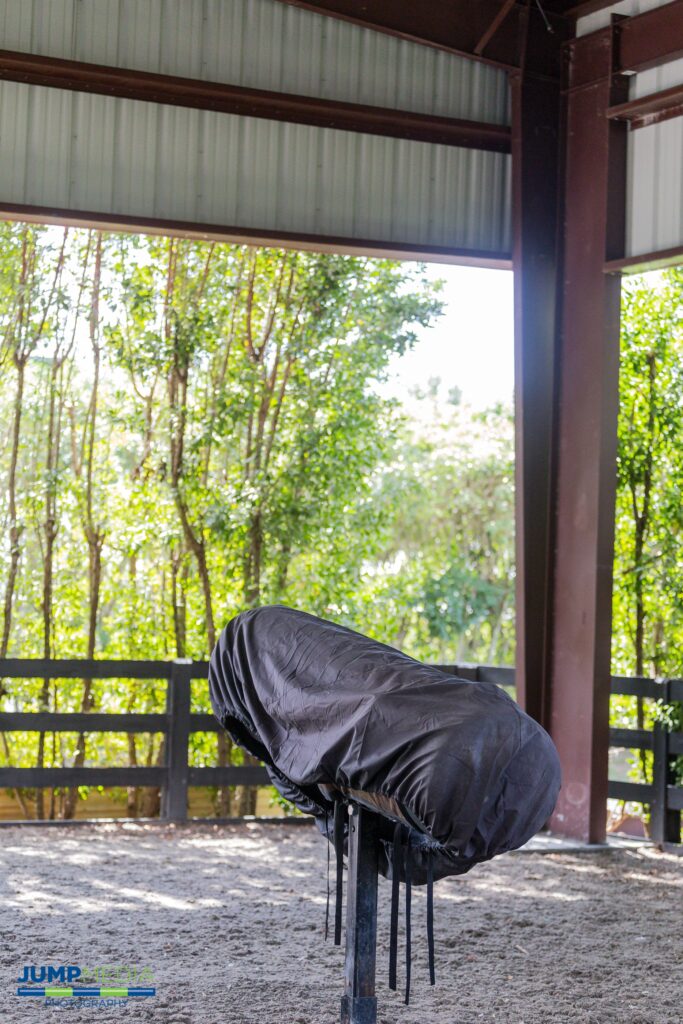
“We can raise or lower our phantom with the push of a button so it can be the appropriate height for the stallion,” said Dr. Atwood. “Previously, we had to bring a tractor in to raise and lower the phantom. We also do not have to take weather into consideration anymore now that the breeding shed is covered. There is enough space and privacy for safe and convenient breeding on-site at Palm Beach Equine Clinic.”
Additionally, Palm Beach Equine Clinic incorporates the use of a SCA® CASA (computer assisted sperm analyzer) system into their reproduction work. An excellent way to improve quality control of a stallion’s sperm, the system evaluates sperm motility (velocity and type of movement), concentration (sperm count), morphology (sperm shape), DNA fragmentation (counting of fragmented sperm), vitality (live and dead count) and acrosome reaction, which is what ultimately allows the sperm to penetrate the egg.
From on-site experience to computer technology, Palm Beach Equine Clinic offers Dr. Atwood the opportunity to be at the forefront of equine reproduction, a place she has always strived to be.
“I wanted to come into a practice that had a developed program in place, but what is even more important to me is mentoring and teaching my technicians and clients about reproduction,” she said. “It is so important to make sure these techniques are shared and promoted for the continued success of veterinarians, owners, and most of all the horses.”
What is Embryo Transfer?
The most popular wave of advancement that has hit the horse sport industry over the past several years is the process of embryo transfer.
Embryo Transfer Process:
- A donor mare and stallion, who hold the genetics of the future foal, are bred.
- At seven or eight days of pregnancy, the embryo is flushed out.
- A catheter is placed through the vagina and cervix, and an inflatable cuff on the catheter provides a fluid-tight seal.
- A lavage fluid with surfactin (added to reduce the “stickiness” of the embryo and allow it to be extracted easily) passes down through a tubing system into the uterine lumen. As the fluid swirls throughout the lumen and drains back out through gravity, it collects the embryo, which is swept back out. The fluid and embryo pass out through the tubing system into and through an embryonic filter.
- When the embryo is identified under a microscope, it is removed into a more enriched medium until the time of transfer.
- The embryo is shipped to a recipient farm where a young and healthy surrogate mare of decent size receives the embryo. That mare carries the foal to term, but it is genetically created from the donor mare and stallion.
Why Breed Through Embryo Transfer?
While the process is fascinating, some may wonder why it’s necessary. According to Dr. Atwood, it relieves much of the concern owners have about sport horse breeding.
Advantages for Mares
“The gestation period for a horse is 11 months, so you’re only getting one foal per year when you breed traditionally,” she said. “This allows a mare to produce multiple foals per year, but it also allows that mare to remain in competition. This process can be done on younger mares with no interruptions to their competition and training schedules.”
Horses are now being bred at an ideal reproductive age while they are still in training, which is made even more valuable by the fact that advances in equine science has prolonged the longevity of horses. While 16 or 17 was once the age of an older horse, now it’s commonly seen as the age when horses are winning in the show ring. Thanks to embryo transfer, these horses can enjoy longer, healthy careers and still produce the talent of the future.
Dr. Atwood has seen embryo transfers become popular in dressage and polo, but she has begun to see it span all disciplines, saying, “At the start of the season, I had one farm and a few mares, but now it has quickly grown to several farms with multiple mares at each. It is really taking off because people now realize it does not remove their mares from competition.”
Advantages for Stallions
The process not only keeps mares competing, but it allows stallions to cross continents. Frozen fertilized embryos from working polo ponies in the U.S. are now being shipped to Argentina where they are carried by mares and then trained by some of the best polo trainers in the world. On the flip side, semen can also be frozen and shipped to the U.S.
“Stallions are collected, the semen is placed with an extender and high nutrient base so the sperm has something to use for energy, and then cooled slowly until it is frozen in liquid nitrogen,” said Dr. Atwood. “Once frozen, it is theoretically good forever. Last year, I bred a mare with 1991 semen and she was successfully pregnant!”
Breeding the Modern Way
Palm Beach Equine Clinic’s Own Dr. Katie Atwood Discusses a 21st Century Take on Equine Reproduction
The process of breeding sport horses is ever-changing. Whether in an effort to produce the healthiest, most talented foals, to prolong the competition career of a mare, or make the most of a stallion’s longevity, reproductive science in horses has come a long way from the days of the traditional breeding shed.
Dr. Katie Atwood joined Palm Beach Equine Clinic, based in Wellington, FL, in June and brought her passion for reproductive work with her to the winter equestrian capital of the world.
“I like the creating of life,” said Dr. Atwood, who is a Florida native and University of Florida graduate and currently pursuing steps to become a board-certified reproductive specialist. “Equine medicine is intriguing, but you’re dealing with sick, unhealthy animals. With reproduction, I am working with healthy animals and making their babies, which I love!”
Embryo Transfer
The most popular wave of advancement that has hit the horse sport industry over the past several years is the process of embryo transfer.
How it works:
- A donor mare and stallion, who hold the genetics of the future foal, are bred.
- At seven or eight days of pregnancy, the embryo is flushed out.
- A catheter is placed through the vagina and cervix, and an inflatable cuff on the catheter provides a fluid-tight seal.
- A lavage fluid with surfactin (added to reduce the “stickiness” of the embryo and allow it to be extracted easily) passes down through a tubing system into the uterine lumen. As the fluid swirls throughout the lumen and drains back out through gravity, it collects the embryo, which is swept back out. The fluid and embryo pass out through the tubing system into and through an embryonic filter.
- When the embryo is identified under microscope, it is removed into a more enriched medium until the time of transfer.
- The embryo is shipped to a recipient farm where a young and healthy surrogate mare of decent size receives the embryo. That mare carries the foal to term, but it is genetically created from the donor mare and stallion.
While the process is fascinating, some may wonder why it’s necessary. According to Dr. Atwood, it relieves much of the concern owners have about breeding their sport horse mares.
“The gestation period for a horse is 11 months, so you’re only getting one foal per year when you breed traditionally,” she said. “This allows a mare to produce multiple foals per year, but it also allows that mare to remain in competition. This process can be done on younger mares with no interruptions to their competition and training schedules.”
Horses are now being bred at an ideal reproductive age while they are still in training, which is made even more valuable by the fact that advances in equine science has prolonged the longevity of horses. While 16 or 17 was once the age of an older horse, now it’s commonly seen as the age when horses are winning in the show ring. Thanks to embryo transfer, these horses can enjoy longer, healthy careers and still produce the talent of the future.
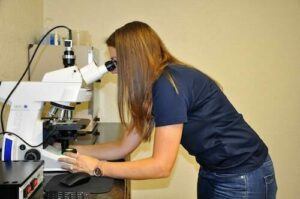
Dr. Atwood has seen embryo transfers become popular in dressage and polo, but she has begun to see it span all disciplines, saying, “At the start of the season, I had one farm and a few mares, but now it has quickly grown to several farms with multiple mares at each. It is really taking off because people now realize it does not remove their mares from competition.”
The process not only keeps mares competing, but it allows stallions to cross continents. Frozen fertilized embryos from working polo ponies in the U.S. are now being shipped to Argentina where they are carried by mares and then trained by some of the best polo trainers in the world. On the flip side, semen can also be frozen and shipped to the U.S.
“Stallions are collected, the semen is placed with an extender and high nutrient base so the sperm has something to use for energy, and then cooled slowly until it is frozen in liquid nitrogen,” said Dr. Atwood. “Once frozen, it is theoretically good forever. Last year, I bred a mare with 1991 semen and she was successfully pregnant!”
What’s Next at Palm Beach Equine Clinic
Palm Beach Equine Clinic underwent significant facility renovations over the last year, which included improvements to their onsite breeding shed. Now covered from the heat and inclement weather like an indoor arena, the shed boasts a hydraulic phantom mare.

“We can raise a lower our phantom with the push of a button so it can be the appropriate for the stallion,” said Dr. Atwood. “Previously, we had to bring a tractor in to raise and lower the phantom.”
Additionally, Palm Beach Equine Clinic recently incorporated the use of a SCA® CASA (computer assisted sperm analyzer) system into their reproduction work. An excellent way to improve quality control of a stallion’s sperm, the system evaluates sperm motility (velocity and type of movement), concentration (sperm count), morphology (sperm shape), DNA fragmentation (counting of fragmented sperm), vitality (live and dead count) and acrosome reaction, which is what ultimately allows the sperm to penetrate the egg.
From onsite experience to computer technology, Palm Beach Equine Clinic offers Dr. Atwood the opportunity to be at the forefront of equine reproduction, a place she has always strived to be.
“I wanted to come into a practice that had a developed program in place, but what is even more important to me is mentoring and teaching my technicians and clients about reproduction,” she said. “It is so important to make sure these techniques are shared and promoted for the continued success of veterinarians, owners, and most of all horses.”
Speak with Dr. Atwood about breeding your horse by filling out the form below
This month, Palm Beach Equine Clinic welcomed a new face to their team. Dr. Katie Atwood, hails from Jacksonville, FL, and attended veterinary school at the University of Florida, making her return to south Florida from Lexington, KY, a special homecoming.
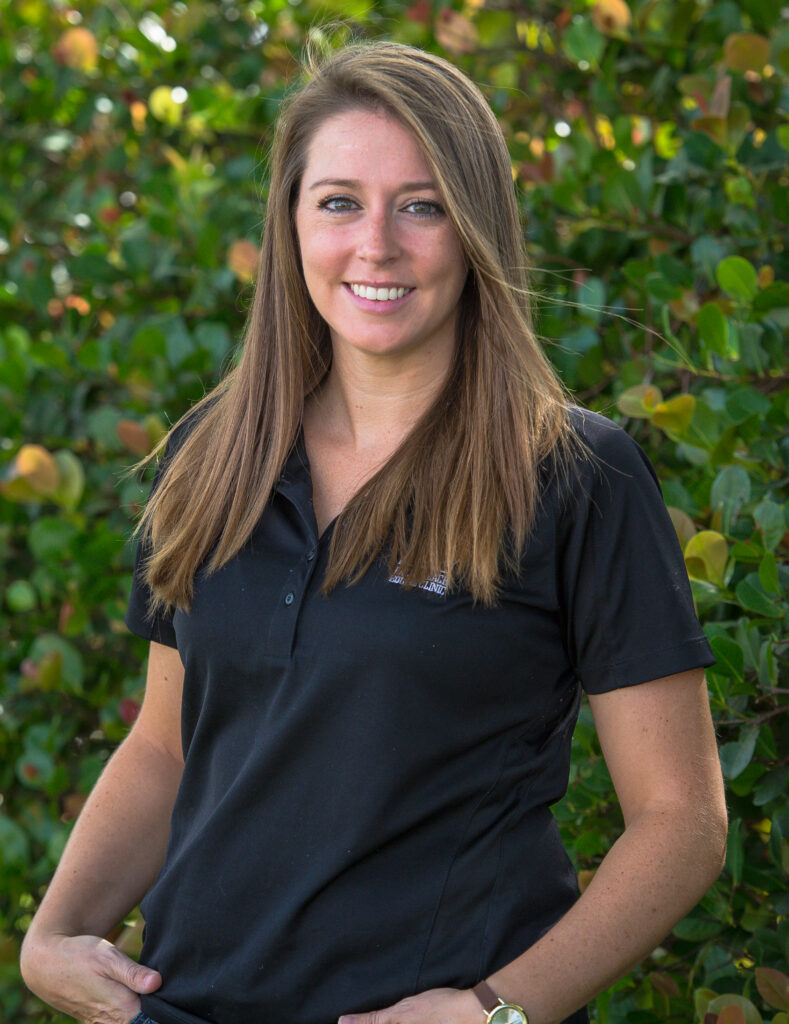
What brought you to Palm Beach Equine Clinic?
I grew up in Florida, so I wanted to be closer to family and the ocean! But, I was also looking for an opportunity to grow and become a better veterinarian. This is a difficult industry to get into, but it is especially difficult to find the right practices. This is a chance for me to work with some of the best doctors in the country.
What would you say is your specialty at Palm Beach Equine Clinic?
In addition to general, preventative and sport medicine, I will be focusing on Palm Beach Equine Clinic’s reproductive work. I did an internship and a fellowship in reproduction and realized that it is what I am most interested in. I will be working on breeding mares, performing frozen and fresh semen inseminations, as well as breeding management and embryo flushes for transfers to recipient mares.
What inspired you to be a veterinarian?
When I was a little kid we had a trail behind our house that was really popular and I would sit on the back wall and watch everybody ride by on their horses. We do not have any other veterinarians in my family, but when I was five years old I realized that I wanted to work with animals. During my undergraduate studies in Animal Science at Berry College in Rome, GA, a professor named Dr. Martin Goldberg really pushed me to pursue veterinary school.
I wake up every morning so excited to go to work and if I don’t come home exhausted and filthy then I have done something wrong. It is an “every minute of every day” commitment, but very rewarding.
When you aren’t working, where can we find you?
I like to spend as much time as possible in the water. I can usually be found swimming, diving or paddleboarding at the beach and spending time by the pool
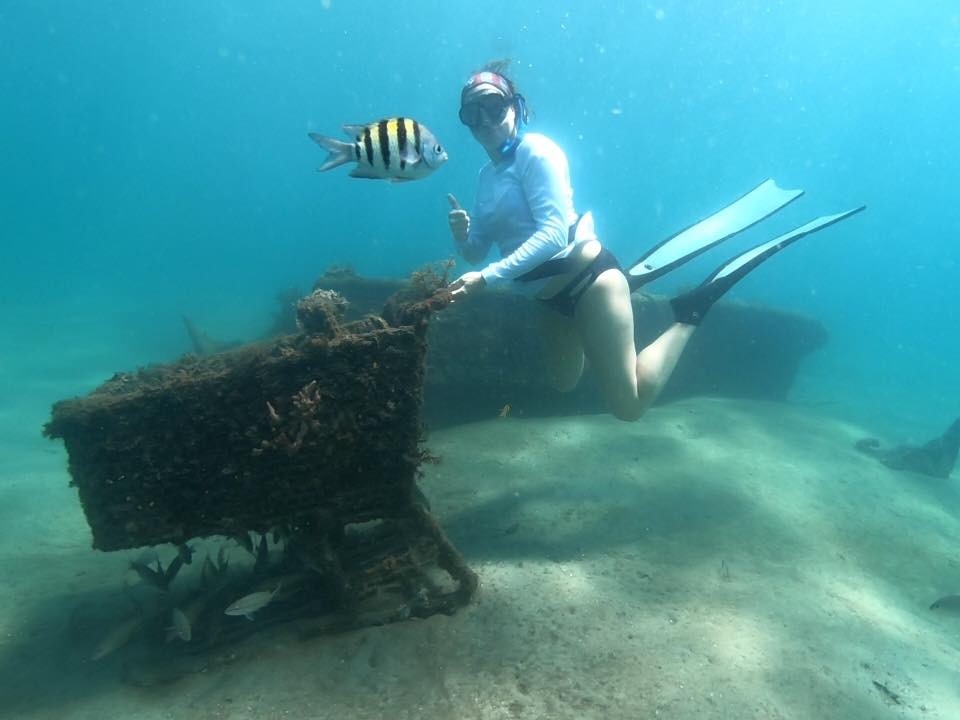
What advice would you give to someone considering pursuing veterinary school?
Do it! It will be the most difficult time of your life, but if you have a passion for it, it will be so rewarding. Dedication is so important; take advantage of every wet lab you can, go to any conference that is available, and take advantage of opportunities to meet new people and gain mentors. Who wouldn’t want to do what they love for a living?
Name one thing most people wouldn’t know about you?
I am a pretty open book at this point. But, when I retire, my fiancé Mackenzie and I want to sail around the world!
